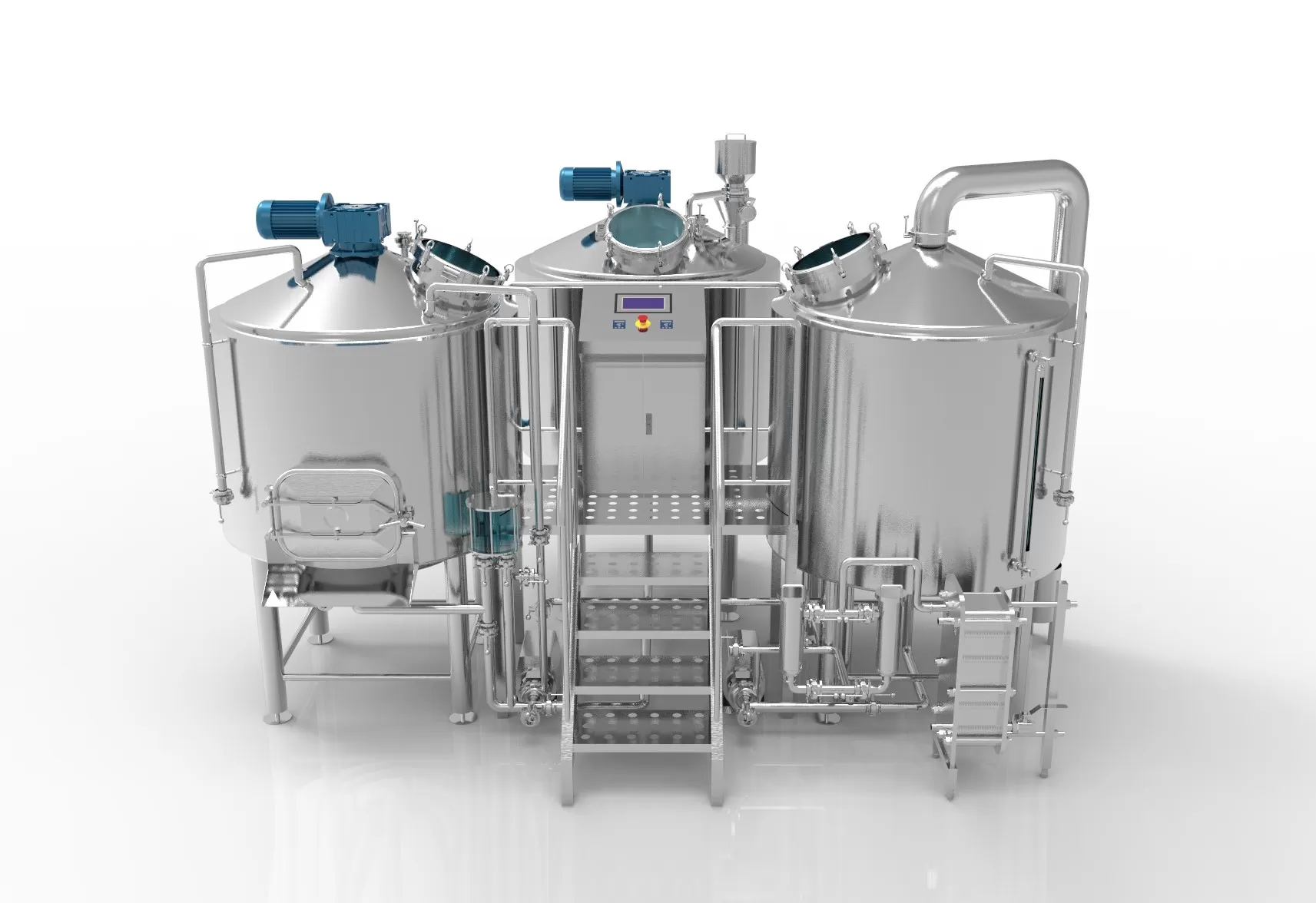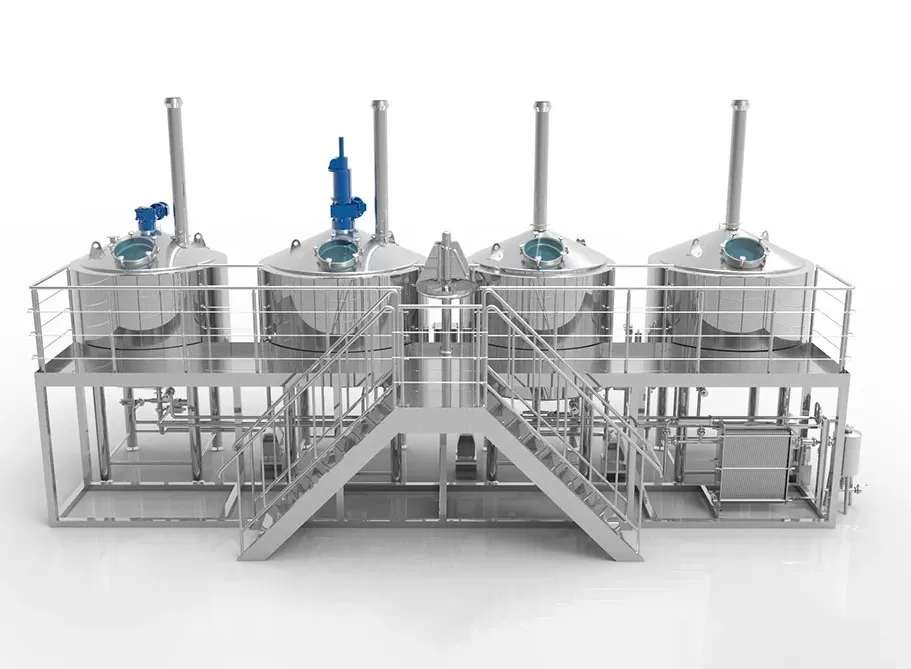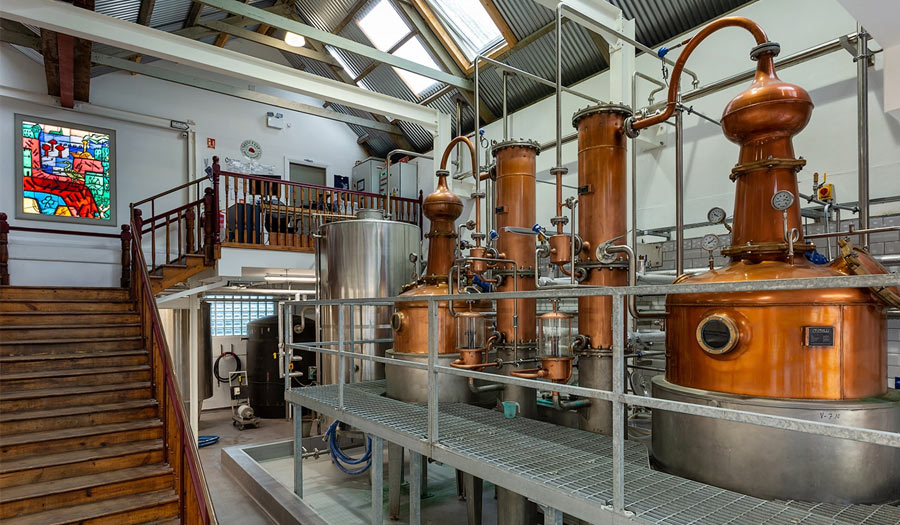양조장의 생산 공정에서 적절한 증류 장비 세트를 갖추는 것은 증류 공정의 효율적이고 안정적인 운영을 보장하기 위한 기초입니다. 이 가이드는 양조장 증류 장비의 이름, 기능, 장비의 특성 및 선택 시 고려해야 할 요소를 포함한 자세한 목록을 제공하여 양조 생산의 요구를 충족하는 완벽한 증류 시스템을 구축하는 데 도움을 줍니다.
주요 유형 및 기능 증류 장비
증류 포트
기능: 증류 공정의 주요 용기로서 증류할 물질을 담습니다. 가열을 통해 재료의 휘발성 성분을 기화시켜 후속 분리를 위한 기초를 제공합니다.
특징
- 일반적으로 장기간 사용 시 재료와 화학적으로 반응하여 제품 품질에 영향을 미치지 않도록 스테인리스 스틸 또는 기타 내식성 재료로 만들어집니다.
- 열전도율이 우수하고 열을 고르게 전달할 수 있어 재료가 고르게 가열되어 국부적인 과열을 방지하고 재료 분해나 코킹을 유발하지 않습니다.
- 다양한 규모의 생산 요구를 충족하기 위해 적절한 용량과 모양으로 설계되었습니다. 일반적으로 대규모 양조장에서는 더 큰 용량의 증류 포트가 필요할 수 있지만 소규모 공장에서는 상대적으로 작은 모델을 선택할 수 있습니다.
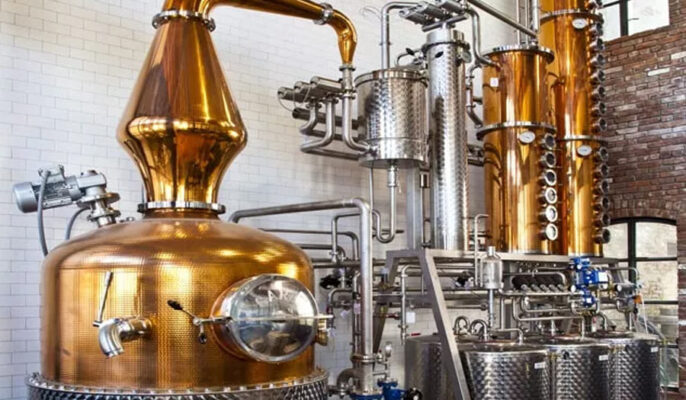
콘덴서
기능: 증류 포트의 기화된 증기를 냉각하고 액체로 응축하여 휘발성 성분과 비휘발성 성분을 분리합니다. 콘덴서는 증류 시스템에 없어서는 안 될 필수 부품이며, 그 효율은 증류 제품의 출력과 품질에 직접적인 영향을 미칩니다.
특징
- 일반적인 콘덴서에는 쉘 및 튜브형, 코일형, 플레이트형이 있습니다. 쉘 앤 튜브 콘덴서는 구조가 간단하고 열교환 효율이 높아 대부분의 양조장의 증류 공정에 적합합니다. 코일 콘덴서는 크기가 작고 설치 면적이 작다는 장점이 있으며 공간이 제한된 경우에 적합합니다. 플레이트 콘덴서는 열전달 계수가 높지만 재료의 청결도에 대한 요구 사항이 높으며 막힘을 방지하기 위해 정기적으로 청소해야 합니다.
- 콘덴서의 재질은 일반적으로 스테인리스 스틸 또는 구리입니다. 구리는 열전도율이 좋지만 가격이 상대적으로 비싸고 일부 특정 환경에서는 부식될 수 있습니다. 스테인리스 스틸은 내식성이 우수하며 현재 더 일반적으로 사용됩니다.
- 냉각 효과를 높이기 위해 응축기에는 일반적으로 냉수 또는 냉각수 순환 펌프와 같은 냉각 매체 순환 시스템이 장착되어 있어 증기를 빠르게 냉각하고 응축할 수 있습니다.
증류탑
기능: 증류탑은 증류 공정의 핵심 장비 중 하나입니다. 다단계 증류를 통해 휘발성 성분의 순도와 분리 효과를 더욱 향상시킵니다. 증류탑에서 증기와 환류 액체는 여러 번의 열교환과 질량 교환을 거쳐 끓는점이 다른 성분을 점차적으로 분리하여 더 순수한 증류 생성물을 얻습니다.
특징
- 증류탑에는 플레이트 타워, 패킹 타워 등 다양한 유형이 있습니다. 플레이트 타워는 구조가 간단하고 작동하기 쉽습니다. 처리량이 많고 분리 요구 사항이 상대적으로 낮은 경우에 적합합니다. 패킹 타워는 분리 효율이 높고 압력 강하가 작다는 장점이 있지만 패킹의 선택과 유지 관리가 상대적으로 복잡합니다.
- 증류탑의 재질은 일반적으로 스테인리스 스틸 또는 기타 부식 방지 재료를 사용하여 증류 주전자의 재질과 동일합니다. 타워 본체는 일반적으로 증기와 환류 액체 사이의 접촉 면적과 접촉 시간을 늘리고 분리 효과를 향상시키기 위해 여러 층의 플레이트 또는 패킹으로 설계됩니다.
- 증류 공정의 온도와 압력을 제어하기 위해 증류탑에는 일반적으로 온도계, 압력계와 같은 계측기와 리보일러 및 콘덴서의 유량 조절 밸브와 같은 해당 조절 장치가 장착되어 실제 생산 조건에 따라 실시간으로 조정됩니다.
선택 시 고려해야 할 요소 증류 장비
생산 규모
양조장의 생산 계획과 시장 수요에 따라 필요한 증류 장비의 생산 능력을 결정합니다. 생산량이 많은 경우 생산 작업을 충족 할 수 있도록 대용량 및 강력한 처리 능력을 갖춘 증류 주전자, 증류탑 및 관련 지원 장비를 선택해야합니다. 예를 들어, 대형 양조장에서는 매일 수 톤 또는 수십 톤의 원료를 처리해야 할 수 있습니다. 이때 대형 증류 장비를 갖추어야 하며 생산 효율성을 높이기 위해 여러 세트의 장비를 병렬로 실행해야 할 수도 있습니다.
머티리얼 속성
재료의 휘발성과 끓는점은 증류 장비를 선택하고 증류 공정을 결정할 때 중요한 요소 중 일부입니다. 물질마다 휘발성과 끓는점 범위가 다릅니다. 휘발성이 강하고 끓는점이 낮은 물질의 경우 증류 공정 중에 상대적으로 낮은 온도와 압력을 사용할 수 있으며 열전달 효율이 높고 냉각 효과가 좋은 증류 장비를 선택하여 에너지 소비와 재료 손실을 줄일 수 있습니다.
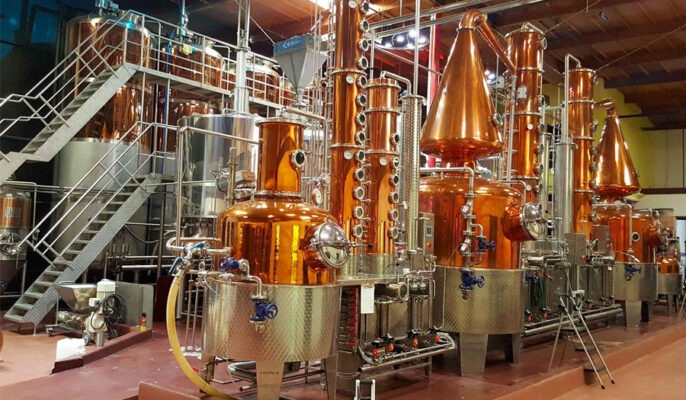
제품 품질 요구 사항
양조 제품마다 증류 제품의 순도에 대한 요구 사항이 다릅니다. 고순도 알코올, 향료 등의 생산과 같이 제품의 순도가 높아야 하는 경우 분리 효율이 높고 불순물을 효과적으로 제거하는 증류 장비와 공정을 선택해야 합니다. 예를 들어, 효율적인 응축기 및 환류 시스템과 함께 정밀 포장 타워 또는 다단계 증류 타워를 사용하면 제품의 순도와 품질을 향상시킬 수 있습니다.
난방 방법
- 증기 가열은 보다 전통적이고 일반적으로 사용되는 가열 방법으로, 균일한 가열, 쉬운 온도 제어 및 높은 열 효율이라는 장점이 있습니다. 증기가 공급되면 증기 난방을 통해 에너지 비용을 절감할 수 있습니다. 그러나 증기 난방에는 증기 발생기 또는 보일러실과 같은 장비가 필요하고 투자 비용이 상대적으로 높으며 증기의 압력과 안정성에 대한 특정 요구 사항이 있습니다.
- 전기 가열은 청결성, 편리성, 높은 제어 정확도 등의 장점이 있으며, 일부 소규모 양조장이나 높은 가열 정확도가 요구되는 경우에 적합합니다. 하지만 전기 가열은 전기 요금이 비싼 지역에서는 상대적으로 비용이 많이 들기 때문에 생산 비용이 증가할 수 있습니다.
- 가스 난방은 난방 속도가 빠르고 비용이 상대적으로 저렴하다는 장점이 있지만 가스 배관 및 관련 안전 장비를 갖춰야 합니다. 가스 난방을 선택할 때는 가스의 품질과 공급 안정성, 장비의 연소 효율과 안전성에 주의를 기울이세요.
증류 장비를 유지보수하고 서비스하는 방법은 무엇인가요?
장비 청소
증류 주전자, 증류탑, 콘덴서 및 기타 장비의 외부 표면을 정기적으로 청소하여 먼지, 오물 및 기타 불순물을 제거하세요. 장비 표면이 긁히지 않도록 깨끗한 젖은 천이나 부드러운 솔로 닦아주세요. 제거하기 어려운 얼룩의 경우 중성 세제를 사용할 수 있지만 세제가 장비 재질을 부식시키지 않는지 확인하세요.
장비 검사
파이프 플랜지, 밸브 인터페이스, 펌프 입구, 출구 등 증류 장비의 다양한 구성 요소 사이의 연결 부품을 매일 점검하세요. 밀봉 개스킷이 손상되지 않았는지, 누출 흔적이 없는지 확인합니다. 경미한 누출의 경우 볼트를 조이거나 밀봉 개스킷을 교체하여 해결할 수 있으며, 누출이 심각한 경우 즉시 장비를 중지하고 수리해야 합니다.

장비 성능 테스트
열전달계수는 입구와 출구 온도, 유량, 가열 또는 냉각 매체 및 재료의 온도 변화를 측정하여 장비의 열전달 성능 저하 여부를 평가하여 계산할 수 있습니다. 열전달계수가 설계값보다 낮은 경우 장비 내부의 스케일, 배관 막힘, 기타 결함 등이 원인일 수 있으므로 추가 점검 및 처리가 필요합니다.
자주 묻는 질문
증류 장비를 시작할 때 주의해야 할 점은 무엇인가요?
시작하기 전에 장비의 연결부가 잘 밀봉되어 있는지, 기기가 정상적으로 표시되는지 확인하고 냉각 시스템, 난방 시스템 등이 정상 작동 상태인지 확인한 다음 작동 절차에 따라 단계별로 장비를 시작하세요.
증류 장비는 얼마나 자주 완전히 유지보수해야 하나요?
일반적으로 장비의 주요 구조 점검, 내부 먼지 청소, 안전 액세서리 확인, 전기 시스템 점검 등 종합적인 유지보수는 1년에 한 번 실시합니다.
증류 장비 내부를 어떻게 청소하나요?
증류주전자와 증류탑의 경우 작동이 완료되고 냉각된 후 적절한 용매 또는 깨끗한 물로 헹굴 수 있습니다. 심한 스케일링의 경우 화학 세제를 사용할 수 있지만 장비 손상을 방지하기 위해 세제 선택에 주의를 기울여야 합니다.


